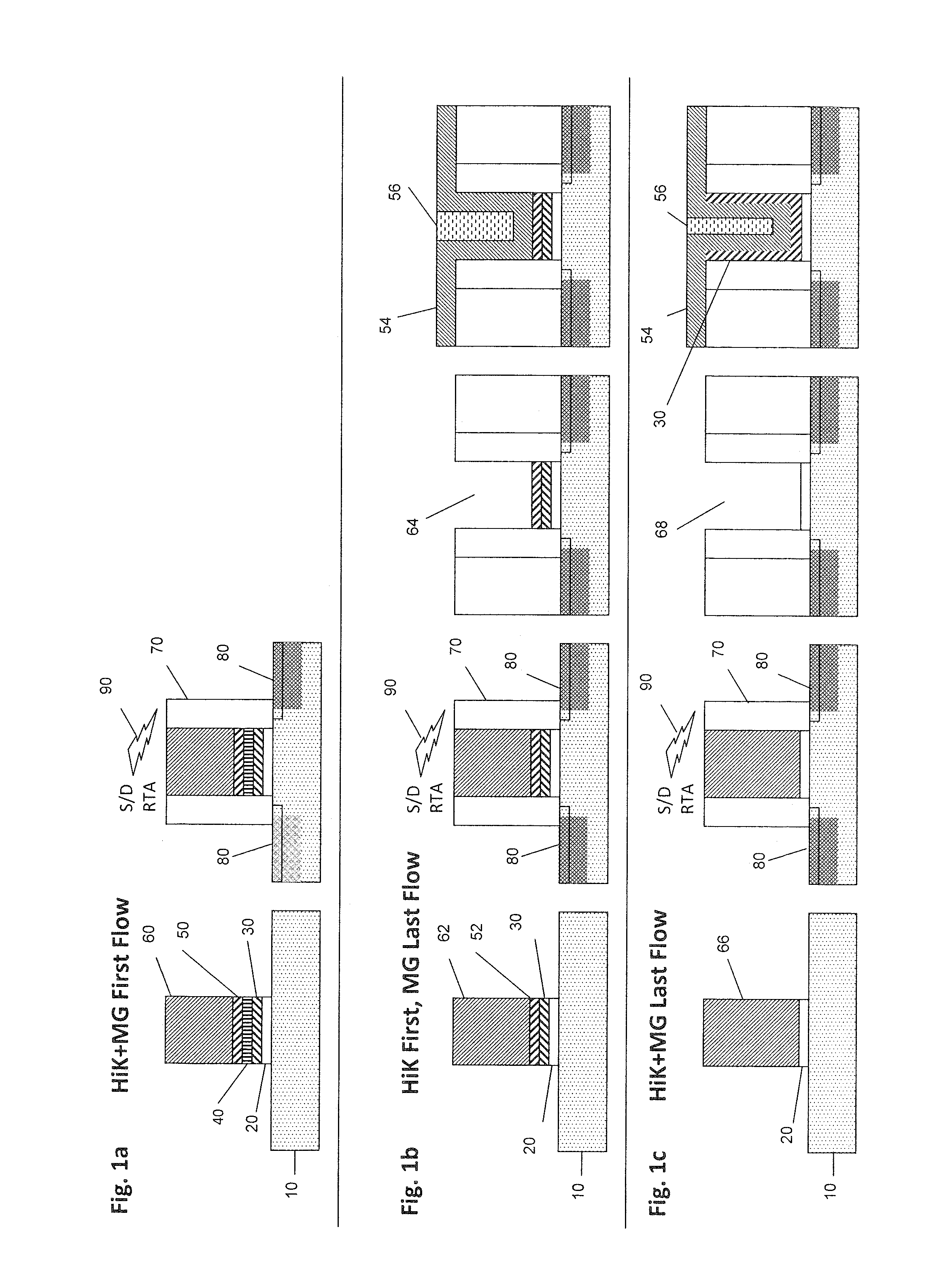Process for depositing electrode with high effective work function
a high-efficiency, electrode-deposited technology, applied in the direction of basic electric elements, electrical equipment, semiconductor devices, etc., can solve the problems of poor performance characteristics of transistors with high-k materials
- Summary
- Abstract
- Description
- Claims
- Application Information
AI Technical Summary
Problems solved by technology
Method used
Image
Examples
example 1
[0058]Example 1 will be discussed with reference to FIGS. 9a-9c. The gate dielectric may include HfO2. From bottom to top, the PMOS metal electrode is formed by deposition of a 2 nm TiN layer, a 1 nm TaCN layer, a 4 nm TiN layer, a 5 nm TiAl layer and a layer of fill metal. The NMOS metal electrode includes, from bottom to top, a 2 nm TiN layer, a 1 nm TaCN layer, a 5 nm TiAl layer, and a layer of fill metal. TiAl provides a low work function for NMOS. In the PMOS stack, however, the TiAl layer is remote from the HfO2 / metal electrode interface and has limited influence on the PMOS stack work function at that HfO2 / metal electrode interface. The treatment with Ar / H* (where H* indicates an excited-hydrogen containing species, such as hydrogen radicals in a plasma) in the PMOS stack can be applied before the TaCN layer deposition (FIGS. 9a and 9b), during the TaCN deposition if a plasma enhanced deposition process is used to form the TaCN layer (FIG. 9c), or after the TaCN layer deposit...
example 2
[0088]Example 2 will be discussed with reference to FIG. 10. The gate dielectric layer may include HfO2. The PMOS metal electrode is formed by deposition of a 2 nm TiN layer, treatment of the TiN layer by a hydrogen containing gas, deposition of a 4 nm TiN layer, and deposition of a fill metal. The NMOS metal electrode includes a first 2 nm TiN layer, a 5 nm TiAl layer, a 4 nm second TiN layer and a fill metal layer. The stacks of FIG. 10 can be produced using the following process flow:[0089]1. Deposition of a first TiN layer and a TiAl layer;[0090]2. Lithography and etch to form a protection layer (e.g. a photo resist layer or SiO2 layer) on NMOS devices;[0091]3. Remove the TiAl layer from PMOS devices, with etch stop on the TiN layer;[0092]4. Treatment in a hydrogen-containing gas;[0093]5. Removal of the protection layer; and[0094]6. Deposition of a second TiN layer and a fill metal.
example 3
[0095]Example 3 will be discussed with reference to FIG. 11. The PMOS electrode is formed by deposition of a 2 nm TiN layer, treatment of the TiN layer in a hydrogen-containing gas, deposition of a 5 nm TaC layer, and deposition of a fill metal layer. The NMOS stack may include a 5 nm TaC layer, and a layer of fill metal. TaC also provides a low work function, suitable for NMOS devices, and comparable to TiAl. However, TaC has the advantage that it can be deposited by ALD whereas TiA1 is typically formed by a PVD process. The stacks of FIG. 11 can be produced by the following process sequence:[0096]1. Deposition of a first TiN layer;[0097]2. Treatment in a hydrogen-containing gas;[0098]3. Lithography and etch (optionally, with a SiO2 hardmask) to remove TiN from NMOS devices, with etch stop on HfO2;[0099]4. (Optional hardmask removal, if applicable);[0100]5. Deposition of a TaC layer to set EWF of NMOS devices; and[0101]6. Deposition of fill metal.
PUM
| Property | Measurement | Unit |
|---|---|---|
| work function | aaaaa | aaaaa |
| peak-to-peak voltage | aaaaa | aaaaa |
| thickness | aaaaa | aaaaa |
Abstract
Description
Claims
Application Information
 Login to View More
Login to View More - R&D
- Intellectual Property
- Life Sciences
- Materials
- Tech Scout
- Unparalleled Data Quality
- Higher Quality Content
- 60% Fewer Hallucinations
Browse by: Latest US Patents, China's latest patents, Technical Efficacy Thesaurus, Application Domain, Technology Topic, Popular Technical Reports.
© 2025 PatSnap. All rights reserved.Legal|Privacy policy|Modern Slavery Act Transparency Statement|Sitemap|About US| Contact US: help@patsnap.com



